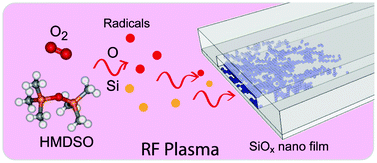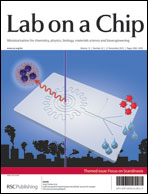We report the controlled diffusion of gas-phase high-reactivity chemical species into long polymeric microcavities to form glass-like, low-permeability barrier films on the interior surfaces of the microcavities. Reactive species created from fragmentation of O2 and hexamethyldisiloxane (HMDSO) in a radio-frequency (RF) plasma environment are allowed to diffuse into the microcavities of polydimethylsiloxane (PDMS), where surface reactions lead to the formation of an effective, glass-like thin-film barrier. Reactive species including silicon radicals and elemental oxygen maintain their reactivity for sufficient times (up to 7000 s) and survive the random diffusional walk through the microcavities to form glass barriers as much as 65 mm from the cavity entrance. The barrier thickness and the growth length can be controlled by the reaction time and chamber operating pressure. Increasing the cross sectional area of the cavity inlet and/or decreasing the mean free path was found to increase the thickness of the barrier film. Optical emission spectroscopic analysis was used to characterize the reactive fragments formed from HMDSO, and energy-dispersive X-ray analysis revealed that the barrier composition is consistent with oxides of silicon (SiOx). Formed inside PDMS microcavities, the glass barrier blocks the penetration or absorption of small molecules such as rhodamine B (RhB) and biotin, and also resists permeation of organic solvents such as toluene, preventing the PDMS microfluidic structures from swelling and deforming. Moreover, formation of glass-like thin films in PDMS microcavities enhances the stability of electroosmotic flow (EOF) relative to uncoated PDMS devices, in which EOF instabilities are significant; this enables separation by electrophoresis with reproducibility (relative standard deviation 3%, n = 5) and baseline peak resolution (R:1.3) comparable to that obtained in conventional fused-silica capillaries.

You have access to this article
 Please wait while we load your content...
Something went wrong. Try again?
Please wait while we load your content...
Something went wrong. Try again?


 Please wait while we load your content...
Please wait while we load your content...